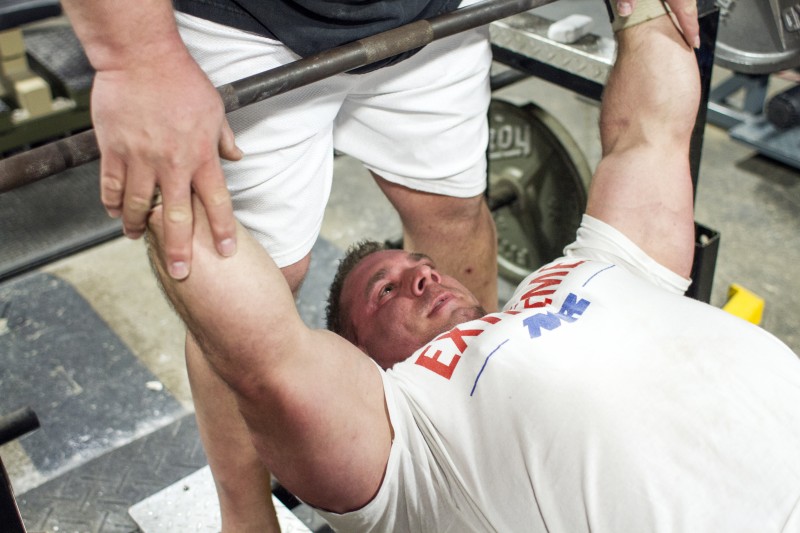
After almost two decades of training, I’m quickly learning that I cannot operate the way I did in my late teens and early 20’s. Back then, I could train hard and dumb and get away with it. Now, if I don’t train intelligently, my body lets me know pretty quickly. Training intelligently means that I need to be aware and listen to my body and know when I can push it and when I need to pull off the gas a little bit. Therefore, I need to make my programming match up to what I’ve learned from my body over the years. What my body has told me is that I can’t go balls-out every training session, every week. I have to wave periods where I push it with periods where I allow myself a little more recovery. Below are several different ways in which waves can be utilized to allow for periods of intense training, along with periods of allowing the body to recover.
Progressive Overload
- Week 1: 3x10 with 50 pounds
- Week 2: 3x10 with 55 pounds
- Week 3: 3x10 with 60 pounds
- Week 4: 3x10 with 65 pounds
The progressive overload setup is more of a baseline for the way many people train. The goal is simple: do more weight than you did the training period prior. This works great for people when they first begin training because their conditioning level is very low and they adapt very quickly. They do get stronger week-to-week and therefore can keep the same volume and relative intensity as their strength increases. The issue with progressive overload is that, as a more advanced lifter, you really aren’t getting that much stronger week-to-week. The ability to progress is more from building coordination in that particular movement and/or starting at a lighter weight the first week and moving to more challenging weights week- to-week. This is a viable option but it doesn’t seem to be ideal for more advanced lifters.
RECENT: How You Can Help Grow The Sport of Powerlifting
Intensity-Based Hypertrophy Wave
- Week 1: 4x8 with 210/70% (32 total reps)
- Week 2: 5x6 with 225/75% (30 total reps)
- Week 3: 6x5 with 240/80% (30 total reps)
- Week 4: 7x4 with 255/85% (28 total reps)
The principle behind this wave is to keep the volume relatively stable throughout the training block and increase the intensity week-to-week. You could run this for three- or four-week waves. Any more than that and it’s difficult to keep the volume stable. The waving of intensity allows you to still hit heavier weights without straining your ability to recover or risking injury.
Working Set Volume-Based Hypertrophy Wave
- Week 1: Work up to a challenging set of 10 reps.
- Week 2: Work up to the same weight you did last week and complete two sets of 10.
- Week 3: Work up to the weight you did last week and complete one set of 10 and one set to failure.
- Week 4: Work up to the weight you did last week and complete two sets of 10 and one set to failure.
This wave keeps the intensity and weight the same each week and just increases volume. This is my favorite wave. It allows you to train with high effort each training session and still enjoy the mental and physical benefits of the wave. The first week you only have one working set, so you can truly work up to a challenging weight without having to worry about hitting it for multiple sets. This is your baseline for what is a good weight for that exercise for you. The first week is also nice because you can get in and get out. If you get tired or can’t always train for two hours every day, it’s nice to have some quick training days thrown in there. Each progressive week you add a little bit more volume, maintaining the same weight you used in the previous weeks. The final two weeks you really push yourself with final sets to failure. This works well with multiple intensities and rep ranges.
Exercise Volume-Based Hypertrophy Wave
All muscle groups trained twice a week.
- Week 1: Two exercises for large muscle groups (chest, back, legs) and one exercise for smaller muscle groups (biceps, triceps, shoulders, calves) of around 30 total working reps
- Week 2: Three exercises for large muscle groups and two exercises for smaller muscle groups of around 30 total working reps
- Week 3: Four exercises for major muscle groups and two exercises for smaller muscle groups of around 30 total working reps
- Week 4: Four exercises plus intensity techniques for major muscle groups and two exercises plus intensity techniques for smaller muscle groups of around 30 total working reps
This is another way you can wave volume, except this time you’re waving the total amount of exercises per muscle group instead of the total sets per exercises. This one is brutal, and by the fourth week, you’re going to feel smoked from doing that many exercises per muscle group twice a week. There are many adaptations you could make with only training muscle groups once a week or twice every week and a half. The idea is that each week you add a new exercise to the mix.
For any lifters who have been stuck on their progress from trying only progressive overload, or for anyone who’s body is starting to fight back, give these different hypertrophy waves a try and you’ll be thankful you did. Train hard and smart to stay in the game.











